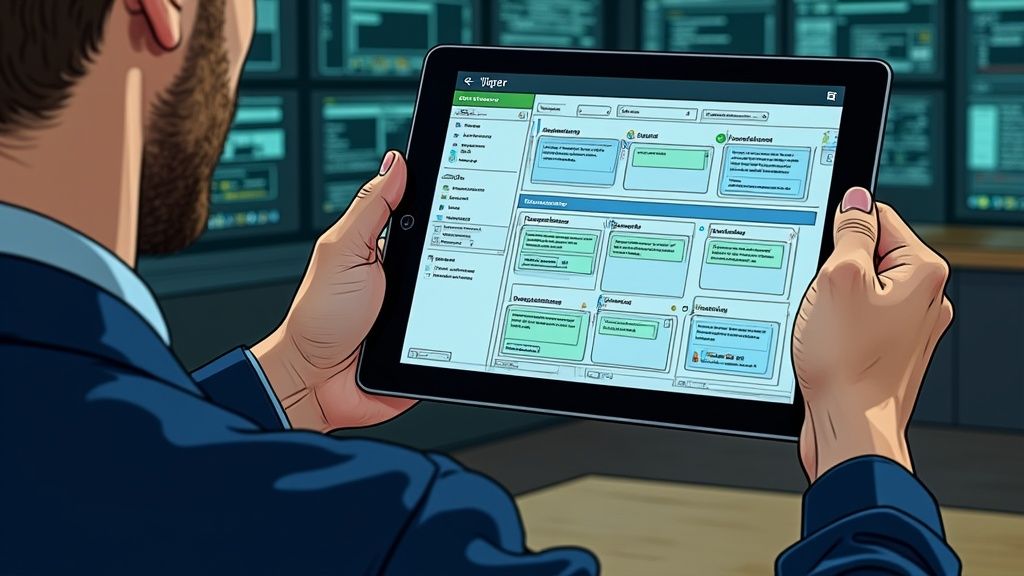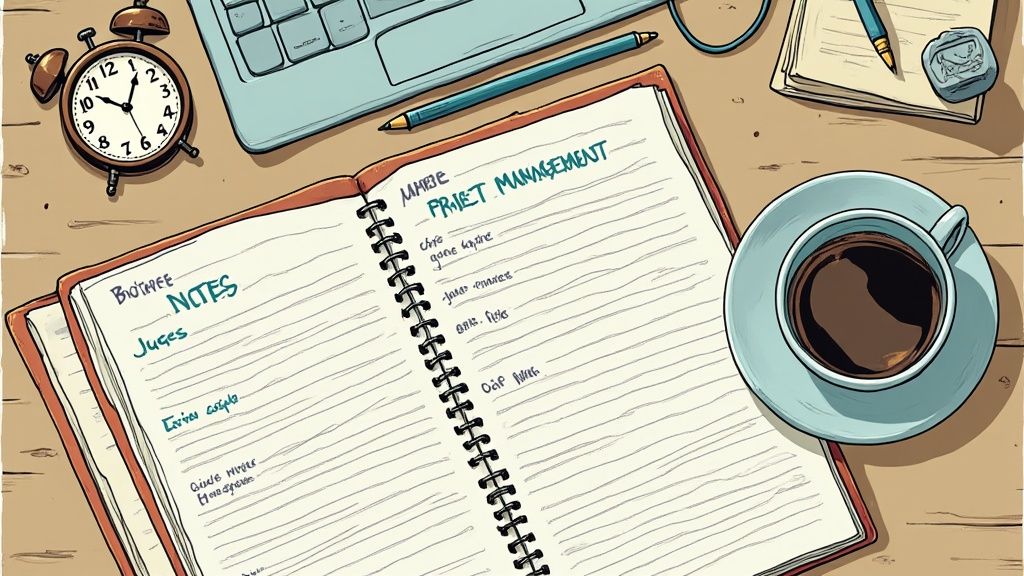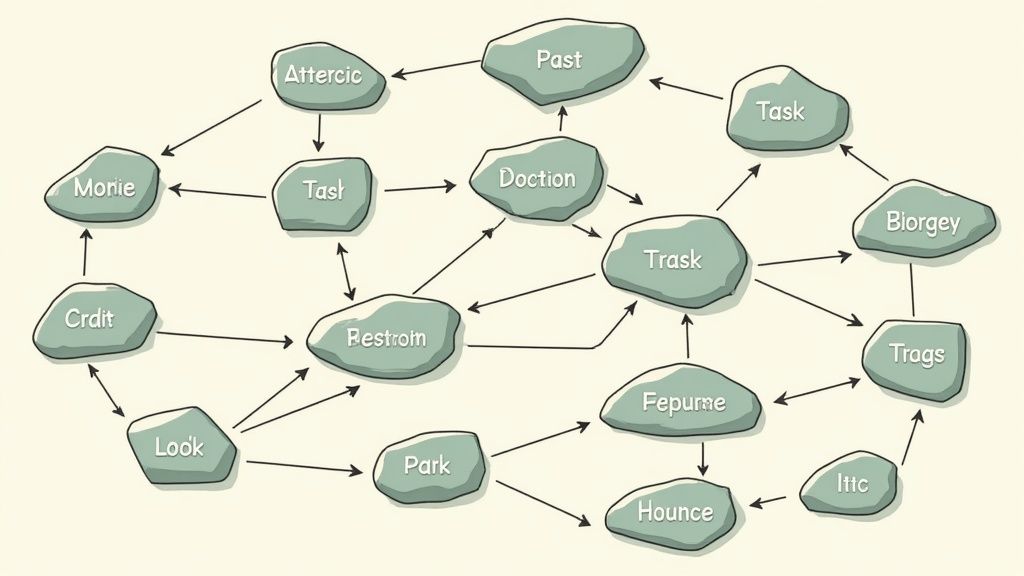Obsidian Project Management: A Complete Guide to Mastering Complex Projects
Transform your project management approach with battle-tested Obsidian strategies. Learn how successful project managers leverage powerful features and proven workflows to deliver outstanding results. meta t: Obsidian Project Management: A Complete Guide to Mastering Complex Projects published: No slug: obsidian-project-management
Understanding Obsidian's Power for Project Management

Obsidian shines as an excellent choice for project management, going beyond basic note-taking. Unlike single-purpose project tools, it gives you the freedom to shape it around your specific workflow. Writers can map out character arcs and plot outlines, while developers can track bugs and feature requests - all in one place. This helps teams stay organized without jumping between multiple apps.
The Power of Bidirectional Linking
The bidirectional linking feature sets Obsidian apart for project work. Think of it like a web of connections between your notes - when you link two pieces of information, you can easily see how they relate to each other. This makes it simple to understand complex projects and spot important connections. For example, you can link meeting notes directly to action items, or connect design mockups to technical requirements.
The linking system helps tackle even the most complex projects with ease. Create a central "Project Hub" note to connect all your tasks, milestones and resources in one view. Link related items like research notes to specific tasks, or connect milestone dates to their deliverables. This gives you a clear picture of project progress at a glance. To learn more about maximizing Obsidian's linking capabilities for projects, check out this detailed guide on Obsidian for project management.
Adaptability for Various Project Needs
Obsidian works well for many different types of projects and teams. Whether you're planning a product launch or organizing a research project, you can set up your workspace to match your exact needs. Add custom templates for common project documents, use plugins that fit your workflow, and create views that show the information most relevant to your team. This flexibility helps everyone work more efficiently with tools shaped around their process.
Building Your Project Command Center in Obsidian
https://www.youtube.com/embed/aFfREf9IQ7Q
Creating an effective project management system in Obsidian starts with setting up clear organization and useful templates. This guide will show you how to build a project management system in Obsidian that fits your specific needs.
Structuring Your Obsidian Vault for Projects
The foundation of good project management in Obsidian is a well-organized vault. Start by creating dedicated folders for each project - for example, a "Website Redesign" project might have subfolders like "Planning," "Design," "Development," and "Launch." This keeps all your project materials in logical, easy-to-find locations.
File naming is just as important as folder structure. Using consistent prefixes like "Meeting Notes - " or "Task - " helps you quickly spot different types of files. This simple system becomes incredibly valuable as your projects grow and you collect more notes.
Making Templates Work for You
Templates save time and keep your project documents consistent. A good meeting notes template, for instance, might include sections for attendees, agenda items, action items, and key decisions.
Here are some essential templates to consider:
Project Overview Template: Sections for goals, stakeholders, timelines, and budget
Meeting Notes Template: Space for attendees, agenda, discussions, and next steps
Task Management Template: Areas to track tasks, deadlines, owners, and status
Well-designed templates make it easier to get started on common project tasks. They also help new team members quickly understand how your project documentation works.
Real-World Project Management Success
Obsidian proves its worth even in large, complex projects. One project leader successfully used Obsidian to manage a team of 150 people plus multiple contractors. By combining the Tasks plugin with daily notes and organized folders, they tracked deadlines, managed tasks, and prepared for meetings more efficiently. You can read more about their experience in this forum post. Their story shows how Obsidian's flexible tools can handle demanding project management needs and improve overall project success.
Conquering Long-Term Project Planning

Managing projects that span months or years requires specific skills and tools. Unlike short-term tasks, these extended projects need careful planning, consistent monitoring, and the ability to adapt along the way. This is where Obsidian shows its strength for project management.
Breaking Down the Big Picture
Starting a long-term project can feel like staring at a mountain you need to climb. The key is breaking it into smaller, achievable milestones. Think of planning a cross-country road trip - you wouldn't just start driving without a plan. You'd map your route, pick your stops, and prepare for unexpected detours.
Tracking Progress Effectively
After setting your milestones, keeping track of progress becomes crucial. Obsidian helps by letting you create specific notes for each milestone and connect them to related tasks and resources. You can use tools like Kanban boards and calendars to see your progress clearly and spot potential issues early.
Adapting to Change: The Long-Term Project Reality
Most long-term projects don't follow the original plan perfectly. Schedules shift, resources change, and new requirements pop up. Obsidian's flexible structure helps you handle these changes smoothly. When you need to adjust a milestone, you can quickly update the connected notes and links to keep everyone in sync. The Mermaid Gantt charts feature is especially helpful for big projects - like managing a PhD research project that might last 3-6 years. One researcher even found these charts helpful in securing funding and staying focused on their timeline. Want to learn more? Check out this guide on managing long-term projects in Obsidian.
Maintaining Momentum and Motivation
Keeping your team engaged throughout a long project is essential. Regular check-ins, clear goals, and celebrating achievements help maintain focus and energy. Obsidian's sharing features create a space where team members can communicate, share documents, and track progress together. This shared ownership helps everyone stay committed to reaching the project's goals.
Maximizing Project Success Through Essential Plugins
Obsidian works well as a basic note-taking app, but plugins make it an exceptional project management tool. The right combination of plugins transforms your vault into a complete project command center, helping you track tasks, visualize progress, and keep complex projects on schedule.
Essential Plugins for Obsidian Project Management
Here are the key plugins that can help streamline your project management workflows:
Tasks: Track and organize tasks with due dates, priorities, and recurring items directly in your notes. Perfect for managing project deliverables and deadlines.
Kanban: Create visual boards to track work progress through different stages. Drag and drop tasks between columns to update their status.
Calendar: See all your project deadlines, meetings and milestones in a calendar view. Helps prevent scheduling conflicts.
Dataview: Pull insights from your project notes using queries. Calculate completion rates, analyze timelines, and spot bottlenecks. Check out more detailed examples in the Obsidian Forum statistics guide.
Advanced Tables: Create and manage project data in tables with sorting, filtering and calculations.
Combining Plugins for Maximum Impact
The real magic happens when you use these plugins together. For example, pair Tasks with Calendar to see deadlines on your schedule. Use Kanban with Dataview to filter and display tasks based on priority or due date. These plugin combinations give you a clearer picture of project status and help you stay in control.
Configuring Plugins for Optimal Results
Take time to set up each plugin properly for your needs. With Tasks, you might create recurring check-ins or set up priority levels. For Kanban, customize the columns and rules to match your project workflow. The right configuration makes plugins much more useful.
Troubleshooting and Best Practices
To keep your plugins running smoothly:
Update plugins regularly
Check for compatibility between plugins
Keep your vault organized
Back up settings and data
Test new plugins in a separate test vault first
Following these guidelines helps you avoid technical issues and get the most from your plugins. With the right setup and maintenance, Obsidian's plugins become reliable tools for managing successful projects.
Mastering Team Collaboration and Communication

Working together smoothly as a team is key to getting projects done well. Obsidian's connected notes and flexible organization make it an excellent choice for teams. Let's explore how to use Obsidian to help your team communicate better and work together more efficiently.
Setting Up Your Team Workspace
Start by creating a shared vault that everyone on the team can access. Keep things organized with clear project folders and consistent file names - for example, "Meeting Notes - Project X" or "Task - Project Y." This makes it easy for team members to find what they need.
Project folder notes work great as central information hubs. Use them to gather key documents, meeting summaries, and important decisions in one place. When paired with Obsibrain, you can manage tasks and track goals right inside Obsidian, making everything more straightforward for the team.
Connecting With Your Team's Tools
Make Obsidian work with your other team tools to get more done. Link your Obsidian notes to project tools like Asana or Trello to keep track of tasks and updates in one place.
Connect Obsidian with chat tools like Slack or Microsoft Teams to keep conversations organized. Share meeting notes directly from Obsidian to your team channels so everyone stays in the loop, even when working at different times.
Tracking Team Progress and Decisions
Use Obsidian's features to manage what everyone's working on. Shared checklists help teams see who's handling which tasks and how they fit into the bigger picture.
Keep a clear record of important decisions in dedicated notes within your shared vault. This ensures everyone understands what was decided and why, which helps avoid confusion later.
Keeping Remote Teams Connected
For teams working in different places, Obsidian serves as a central hub for sharing knowledge and staying in touch. Use shared vaults and clear communication channels to keep everyone moving forward together. Regular check-ins and progress updates in your shared vault help team members stay connected and engaged, even when working across different time zones.
Avoiding Common Pitfalls and Maximizing Success

Setting up Obsidian for project management is just the first step. To get the most out of this powerful tool, you need to understand potential challenges and develop smart ways to overcome them. Let's look at key areas where teams often stumble and how to avoid these common issues.
Folder Structures and Organization
Many teams struggle with messy folder structures. While Obsidian gives you lots of freedom in organization, a disorganized vault quickly becomes hard to navigate. Keep your work and personal notes separate - create a dedicated "Projects" folder with clear subfolders for each project. Within these, add specific folders like "Meetings," "Research," and "Tasks."
File names matter more than you might think. As your projects grow, consistent naming helps everyone find what they need. Use clear prefixes like "Meeting Notes - " or "Task - " to make searching and filtering easier. This simple step can save hours of hunting for information later on.
Effective Linking Strategies
Links are great, but they need context. Just connecting notes without explaining why can create confusion. Think of it like a spider web - if you can't tell why notes are connected, the web becomes a mess. Add clear descriptions to your links and brief summaries that explain the connections between notes.
Plugin Management and Maintenance
Obsidian's plugins add helpful features, but too many can cause problems. Pick only the plugins you really need for project management. Test new ones in a separate vault first to avoid breaking your main workspace. Keep your plugins updated and remove any you don't use regularly.
Adapting and Evolving Your System
Your project management needs will change over time. Many teams stick with their initial setup too long, even when it's not working well anymore. Check your system monthly - are your folders still logical? Do your templates still make sense? When your team grows or starts using new tools, adjust your Obsidian setup to match.
Maximizing Obsidian with Obsibrain
If you want to make Obsidian work better for your team, check out Obsibrain. It adds task management, habit tracking, and project planning right inside Obsidian. Instead of jumping between different apps, your team can handle everything in one place. Learn more about how Obsibrain can help your team work better in Obsidian.
Last updated
Was this helpful?